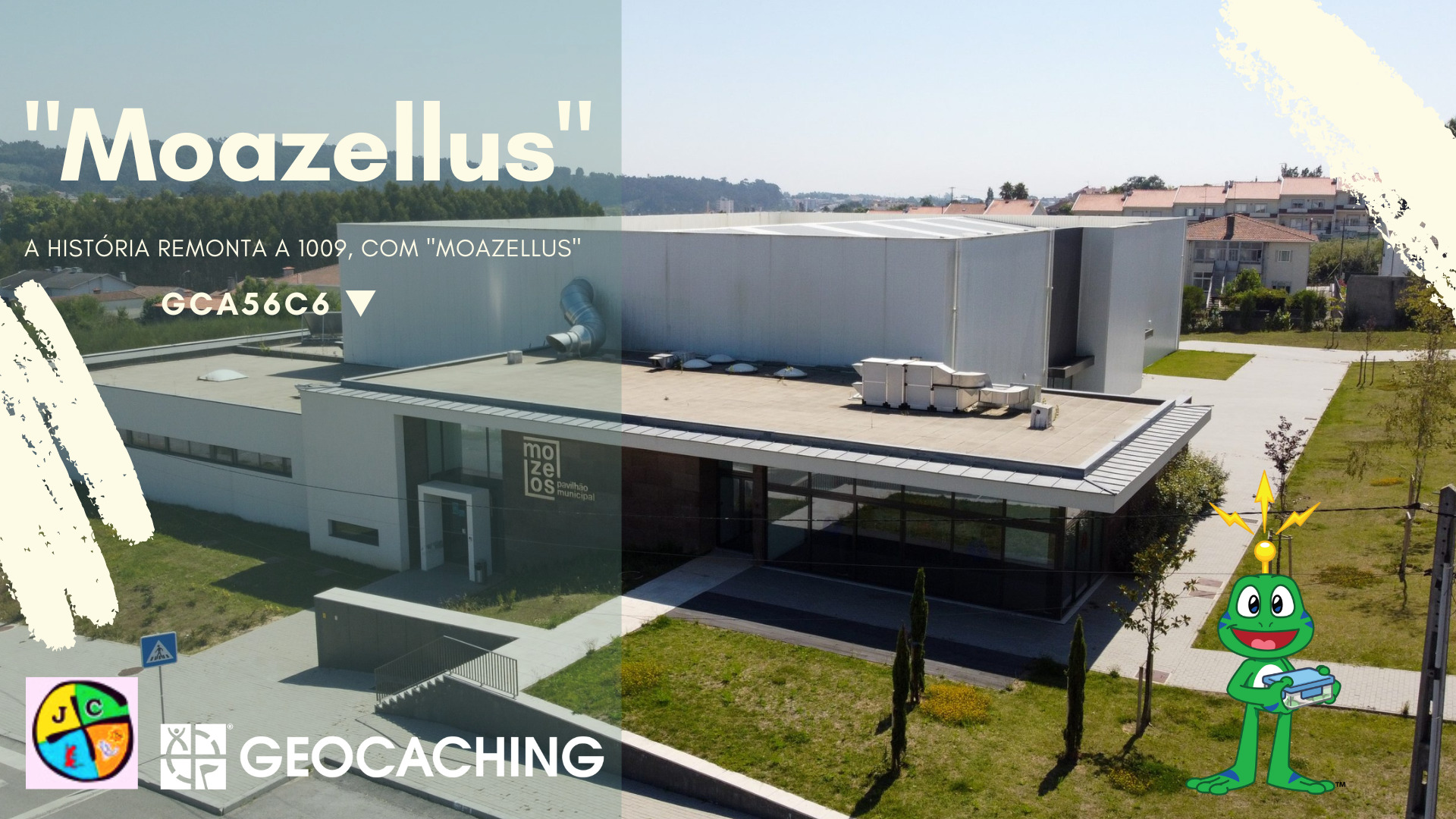🇵🇹
Esta geocache está localizada na Freguesia de Mozelos, concelho de Santa Maria da Feira, distrito de Aveiro.
🇬🇧
This geocache is located in the Parish of Mozelos, municipality of Santa Maria da Feira, district of Aveiro.

🇵🇹
A HISTÓRIA REMONTA A 1009, COM "MOAZELLUS"
As primeiras referências a Mozelos remontam a um documento de 1009, onde se faz a referência a "Moazellus".
🇬🇧
HISTORY GOES BACK TO 1009, WITH "MOAZELLUS"
The first references to Mozelos date back to a document from 1009, where reference is made to "Moazellus".
🇵🇹
Um pouco desta rica História
Mozelos é uma freguesia portuguesa do concelho de Santa Maria da Feira, com 5,04 km2; de área e 7 142 habitantes (2011) e atualmente próxima dos dez mil habitantes. Situa-se a norte do Concelho de Santa Maria da Feira distando cerca de 13 km da sede de Concelho e 20 km a sul da cidade do Porto, com 21 lugares. Densidade (2011): 1 417,1 hab/km2;.
Uma lenda local refere que a toponímia derivou de uma antiga dama de origem franca (madamemoiselle) que vivia naquele local. Com o tempo Madamemoiselle passou a Moazellus, que acabou mais tarde por se tornar Mozelos. Pertence ao Bispado do Porto e ao 1º Distrito Eclesiástico da Feira, tendo como Orago S. Martinho cuja atual Igreja Matriz foi construída na 2ª metade do século XIX.
As primeiras referências a Mozelos conhecidas, remontam a um documento de 1009 onde se faz referência a “Moazellus”. Mozelos foi incluído no Foral da Feira (Terra de Santa Maria) concedido por El-Rei D. Manuel I em Lisboa a 10 de Março de 1514.
A Ordem de Malta ou do Hospital, com sede em Rio Meão, também possuía em Mozelos Bens e Foros. Esta Ordem tinha anexada a si a maior parte da freguesia de Santa Maria de Meladas, extinta no final do século XV, devido a uma grande peste que dizimou quase toda a população. Ainda hoje existe, no lugar de Meladas (mais propriamente na Quinta de Meladas) uma pequena Capela comemorativa da antiga Igreja Paroquial que aí existiu no século XII, bem como marcos nas extremas da Freguesia, com a inscrição da “Cruz de Malta”.
No princípio do século XIX, a 11 de Maio de 1809, um facto que associou eternamente a Freguesia de Mozelos às invasões Francesas. Nesse dia, pelo facto de terem aparecido mortos 3 soldados franceses, como represália, os invasores fuzilaram 7 inocentes (incluindo o padre João Sá Rocha) e posteriormente penduraram os respetivos cadáveres nos ramos de um secular “Pinheiro” que existia junto à atual EN 1 (Porto – Lisboa) próximo do lugar do Picôto, onde permaneceram durante algum tempo para mostrar um aviso aos invadidos, passando o dito “Pinheiro” a ser conhecido pelo “Pinheiro das Sete Cruzes”, tendo sido edificada no local uma pequena ermida em 1885, que ainda hoje se encontra em bom estado de conservação. O “Pinheiro das Sete Cruzes” faz parte do Brasão da Vila nos dias atuais.
Em 19 de Setembro de 1982 foi inaugurada a atual sede da Junta de Freguesia e, em 1 de Dezembro de 2001, foi inaugurada a Capela Mortuária e concluído o terceiro alargamento do Cemitério. A elevação de Mozelos à categoria de Vila, deliberado em reunião plenária da Assembleia da República, em 30 de Junho de 1989, consta do Diário da República, 1ª série, nº99 de 1 de Julho de 1989 e foi publicada como a Lei nº 47/99 de 29 de Agosto de 1989. Tem também parte de uma estrada romana como vestígio da passagem dos mesmos. Pensa-se que esta estrada teria ligação com outra do Alto Minho, a qual iria ter à Galiza. Um dos mais famosos filhos desta freguesia terá sido Manuel Laranjeira. Tendo-se formado médico, foi reconhecido pelas suas publicações sobre a política da época. Mozelos é ainda um grande centro nacional de produção de derivados de cortiça. Américo Amorim (um dos fundadores da Amorim & Irmão), nascido em Mozelos, é um dos expoentes máximos deste género de negócio e o homem mais rico de Portugal.
🇬🇧
A bit of this rich history
Mozelos is a Portuguese parish in the municipality of Santa Maria da Feira, with 5.04 km2; in area and 7,142 inhabitants (2011) and currently close to ten thousand inhabitants. It is located to the north of the Municipality of Santa Maria da Feira, approximately 13 km from the municipality seat and 20 km south of the city of Porto, with 21 places. Density (2011): 1 417.1 inhabitants/km2;.
A local legend states that the toponymy derived from an old lady of Frankish origin (madamemoiselle) who lived in that place. Over time Madamemoiselle became Moazellus, which later became Mozelos. It belongs to the Bishopric of Porto and the 1st Ecclesiastical District of Feira, having as Orago S. Martinho whose current Mother Church was built in the second half of the 19th century.
The first known references to Mozelos date back to a document from 1009 where reference is made to “Moazellus”. Mozelos was included in the Foral da Feira (Terra de Santa Maria) granted by King D. Manuel I in Lisbon on March 10, 1514.
The Order of Malta or the Hospital, based in Rio Meão, also owned goods and forums in Mozelos. This Order had annexed most of the parish of Santa Maria de Meladas, extinct at the end of the 15th century, due to a great plague that decimated almost the entire population. Even today, in Meladas (more specifically in Quinta de Meladas) there is a small commemorative chapel of the old Parish Church that existed there in the 12th century, as well as landmarks at the ends of the parish, with the inscription of the “Cruz de Malta”.
At the beginning of the 19th century, on May 11, 1809, a fact that forever associated the Parish of Mozelos with the French invasions. On that day, due to the fact that 3 French soldiers were found dead, as a reprisal, the invaders shot 7 innocent people (including Father João Sá Rocha) and later hung their corpses on the branches of a secular “Pinheiro” that existed next to the current EN 1 (Porto – Lisbon) near Picôto, where they stayed for some time to show a warning to the invaded, and the so-called “Pinheiro” became known as “Pinheiro das Sete Cruzes”, with a small chapel being built on the spot in 1885 , which is still in good condition today. The “Pinheiro das Sete Cruzes” is part of the coat of arms of the village today.
On September 19, 1982, the current seat of the Parish Council was inaugurated and, on December 1, 2001, the Mortuary Chapel was inaugurated and the third extension of the Cemetery was completed. The elevation of Mozelos to the category of town, deliberated in a plenary meeting of the Assembly of the Republic, on June 30, 1989, appears in the Diário da República, 1st series, nº 99 of July 1, 1989 and was published as Law nº 47/ 99 of August 29, 1989. It also has part of a Roman road as a trace of their passage. It is thought that this road would have a connection with another one in Alto Minho, which would lead to Galicia. One of the most famous sons of this parish was Manuel Laranjeira. Having trained as a doctor, he was recognized for his publications on the politics of the time. Mozelos is also a major national center for the production of cork derivatives. Américo Amorim (one of the founders of Amorim & Irmão), born in Mozelos, is one of the greatest exponents of this type of business and the richest man in Portugal.

🇵🇹
Origem
Mozelos é uma freguesia portuguesa do concelho de Santa Maria da Feira, com 5,04 km⊃2; de área e 7 142 habitantes (2011) e atualmente próxima dos dez mil habitantes. Situa-se a norte do Concelho de Santa Maria da Feira distando cerca de 13 km da sede de Concelho e 20 km a sul da cidade do Porto, com 21 lugares. Densidade (2011): 1 417,1 hab/km⊃2;.
Uma lenda local refere que a toponímia derivou de uma antiga dama de origem franca (madamemoiselle) que vivia naquele local. Com o tempo Madamemoiselle passou a Moazellus, que acabou mais tarde por se tornar Mozelos. Pertence ao Bispado do Porto e ao 1º Distrito Eclesiástico da Feira, tendo como Orago S. Martinho cuja atual Igreja Matriz foi construída na 2ª metade do século XIX.
As primeiras referências a Mozelos conhecidas, remontam a um documento de 1009 onde se faz referência a “Moazellus”. Mozelos foi incluído no Foral da Feira (Terra de Santa Maria) concedido por El-Rei D. Manuel I em Lisboa a 10 de Março de 1514.
A Ordem de Malta ou do Hospital, com sede em Rio Meão, também possuía em Mozelos Bens e Foros. Esta Ordem tinha anexada a si a maior parte da freguesia de Santa Maria de Meladas, extinta no final do século XV, devido a uma grande peste que dizimou quase toda a população. Ainda hoje existe, no lugar de Meladas (mais propriamente na Quinta de Meladas) uma pequena Capela comemorativa da antiga Igreja Paroquial que aí existiu no século XII, bem como marcos nas extremas da Freguesia, com a inscrição da “Cruz de Malta”.
No princípio do século XIX, a 11 de Maio de 1809, um facto que associou eternamente a Freguesia de Mozelos às invasões Francesas. Nesse dia, pelo facto de terem aparecido mortos 3 soldados franceses, como represália, os invasores fuzilaram 7 inocentes (incluindo o padre João Sá Rocha) e posteriormente penduraram os respetivos cadáveres nos ramos de um secular “Pinheiro” que existia junto à atual EN 1 (Porto – Lisboa) próximo do lugar do Picôto, onde permaneceram durante algum tempo para mostrar um aviso aos invadidos, passando o dito “Pinheiro” a ser conhecido pelo “Pinheiro das Sete Cruzes”, tendo sido edificada no local uma pequena ermida em 1885, que ainda hoje se encontra em bom estado de conservação. O “Pinheiro das Sete Cruzes” faz parte do Brasão da Vila nos dias atuais.
Em 19 de Setembro de 1982 foi inaugurada a atual sede da Junta de Freguesia e, em 1 de Dezembro de 2001, foi inaugurada a Capela Mortuária e concluído o terceiro alargamento do Cemitério.
A elevação de Mozelos à categoria de Vila, deliberado em reunião plenária da Assembleia da República, em 30 de Junho de 1989, consta do Diário da República, 1ª série, nº99 de 1 de Julho de 1989 e foi publicada como a Lei nº 47/99 de 29 de Agosto de 1989.
Tem também parte de uma estrada romana como vestígio da passagem dos mesmos. Pensa-se que esta estrada teria ligação com outra do Alto Minho, a qual iria ter à Galiza.
Um dos mais famosos filhos desta freguesia terá sido Manuel Laranjeira. Tendo-se formado médico, foi reconhecido pelas suas publicações sobre a política da época.
Mozelos é ainda um grande centro nacional de produção de derivados de cortiça. Américo Amorim (um dos fundadores da Amorim & Irmão), nascido em Mozelos, é um dos expoentes máximos deste género de negócio e o homem mais rico de Portugal.
Fonte: https://jf-mozelos.pt/
🇬🇧
Origin
Mozelos is a Portuguese parish in the municipality of Santa Maria da Feira, with 5.04 km⊃2; in area and 7,142 inhabitants (2011) and currently close to ten thousand inhabitants. It is located to the north of the Municipality of Santa Maria da Feira, approximately 13 km from the municipality seat and 20 km south of the city of Porto, with 21 places. Density (2011): 1 417.1 inhab/km⊃2;.
A local legend states that the toponymy derived from an old lady of Frankish origin (madamemoiselle) who lived in that place. Over time Madamemoiselle became Moazellus, which later became Mozelos. It belongs to the Bishopric of Porto and the 1st Ecclesiastical District of Feira, having as Orago S. Martinho whose current Mother Church was built in the second half of the 19th century.
The first known references to Mozelos date back to a document from 1009 where reference is made to “Moazellus”. Mozelos was included in the Foral da Feira (Terra de Santa Maria) granted by King D. Manuel I in Lisbon on March 10, 1514.
The Order of Malta or the Hospital, based in Rio Meão, also owned goods and forums in Mozelos. This Order had annexed most of the parish of Santa Maria de Meladas, extinct at the end of the 15th century, due to a great plague that decimated almost the entire population. Even today, in Meladas (more specifically in Quinta de Meladas) there is a small commemorative chapel of the old Parish Church that existed there in the 12th century, as well as landmarks at the ends of the parish, with the inscription of the “Cruz de Malta”.
At the beginning of the 19th century, on May 11, 1809, a fact that forever associated the Parish of Mozelos with the French invasions. On that day, due to the fact that 3 French soldiers were found dead, as a reprisal, the invaders shot 7 innocent people (including Father João Sá Rocha) and later hung their corpses on the branches of a secular “Pinheiro” that existed next to the current EN 1 (Porto – Lisbon) near Picôto, where they stayed for some time to show a warning to the invaded, and the so-called “Pinheiro” became known as “Pinheiro das Sete Cruzes”, with a small chapel being built on the spot in 1885 , which is still in good condition today. The “Pinheiro das Sete Cruzes” is part of the coat of arms of the village today.
On September 19, 1982, the current seat of the Parish Council was inaugurated and, on December 1, 2001, the Mortuary Chapel was inaugurated and the third enlargement of the Cemetery was completed.
The elevation of Mozelos to the category of town, deliberated in a plenary meeting of the Assembly of the Republic, on June 30, 1989, appears in the Diário da República, 1st series, nº 99 of July 1, 1989 and was published as Law nº 47/ 99 of August 29, 1989.
It also has part of a Roman road as a trace of their passage. It is thought that this road would have a connection with another one in Alto Minho, which would lead to Galicia.
One of the most famous sons of this parish was Manuel Laranjeira. Having trained as a doctor, he was recognized for his publications on the politics of the time.
Mozelos is also a major national center for the production of cork derivatives. Américo Amorim (one of the founders of Amorim & Irmão), born in Mozelos, is one of the greatest exponents of this type of business and the richest man in Portugal.
Source: https://jf-mozelos.pt/
